|
|
|
Sort Order |
|
|
|
Items / Page
|
|
|
|
|
|
|
| Srl | Item |
| 1 |
ID:
133045
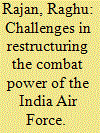

|
|
|
|
|
| Publication |
2014.
|
| Summary/Abstract |
The IAF's capability covers the IOR counties on the maritime side and its principal adversaries Pakistan and China on the landward side
|
|
|
|
|
|
|
|
|
|
|
|
|
|
|
|
| 2 |
ID:
133050
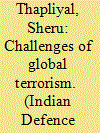

|
|
|
|
|
| Publication |
2014.
|
| Summary/Abstract |
There should be no distinction between a good and a bad terrorist which is what some countries are trying to do. The scourge will consume all unless it is ruthlessly eliminated. Countries sponsoring terrorism might realise that it is like riding a tiger that, one day, they might tall prey to. The biggest worry at these countries which have sulterecl at the hands at terrorists is that Weapons of Mass Destruction may fall into the hands at the terrorists and that catastrophic consequences would tollowi A worldwide integrated approach to tackling terrorism is, therefore, a must.
|
|
|
|
|
|
|
|
|
|
|
|
|
|
|
|
| 3 |
ID:
133059


|
|
|
|
|
| Publication |
2014.
|
| Summary/Abstract |
The Indian soldiers, on account to their faith in the otters who lead them, their innate goodness and the discipline that has been ingrained in them have a great capacity to accept and absorb wrongs but it these continue to happen on a sustained and regular basis, as is happening, then it would be foolish to expect them to keep accepting policies that are patently discriminatory! The aspirations at the military may continue to be ignored but at the risk ot a revolt, or even a coup!
|
|
|
|
|
|
|
|
|
|
|
|
|
|
|
|
| 4 |
ID:
133054
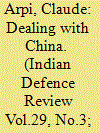

|
|
|
|
|
| Publication |
2014.
|
| Summary/Abstract |
How to deal with China has been a problem for the Indian diplomacy trom the day the People's Liberation Army entered Eastern Tibet in October 1950. South Block (both the Ministry of External Attairs and Detence) has otten been on the wrong side at history, especially during the bhai-bhai era, What can be done to give a tresh impetus to India's engagement with Beijing, while dealing in a more appropriate way with China?
|
|
|
|
|
|
|
|
|
|
|
|
|
|
|
|
| 5 |
ID:
133047
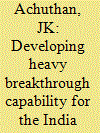

|
|
|
|
|
| Publication |
2014.
|
| Summary/Abstract |
A 'heavy breakthrough capability' in India's context relates to having the capability to reach objectives up to 100km in depth, should the political circumstances impose war on our nation.
Our democratic set up will never allow India to become the aggressor, as the people's support will never be available for even thinking at such dangerous and unproductive ventures. India
does not believe in either territorial conquest or torcible amalgamation ot unwilling or a dillerent
type of population. Such actions can only be carried out by totalitarian regimes which can easily misrepresent tacts to their countrymen and live a lie while festering rebellions gather smoke waiting tor the central authority's power to wane. It was exactly such a situation that arose in the erstwhile Soviet Union leading to its break up.
|
|
|
|
|
|
|
|
|
|
|
|
|
|
|
|
| 6 |
ID:
133051
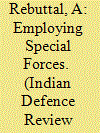

|
|
|
|
|
| Publication |
2014.
|
| Summary/Abstract |
In the Indian context, the Parachute Brigade, being the only formation of its kind available nationally, has performed the dual role of being a strategic reserve tasked for conventional operations, and also that of acting as a rapid reaction force capable of intervention/forced entry in OOAC as was carried out during Op Cactus in the Maldives in 1988. This latter role has subsequently gained in importance due to the nuclearisation of the subcontinent and the substantial reduction in operational battle space that resulted, and also because ot our increasing economic and geo-political clout in the region. Thus, we have created a unique beast, neither Ranger nor Airborne; a potent mix that fulfills both its roles in our area of influence and that has, over the years, met our requirements admirably.
|
|
|
|
|
|
|
|
|
|
|
|
|
|
|
|
| 7 |
ID:
133052
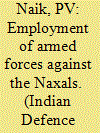

|
|
|
|
|
| Publication |
2014.
|
| Summary/Abstract |
The origin of the Noxal problem is attributable to sociopolitical and socio-economic repression. The poor and Scheduled Castes (SC) were downtrodden by the Zamindars. Land reforms were nowhere. Forest land was shrinking. Added to that there was no development, in tact, governance was sorely lacking. At tirst, the states sought to control the problem through the state police torces. Most of the police were in a poor state. Numbers, inlrastructure, weapons were minimal. They were swiltly rendered inetlective ond the Pora Military Forces (PMF) were called in. Additionally, the movement became more coordinated and stretched across state boundaries.
|
|
|
|
|
|
|
|
|
|
|
|
|
|
|
|
| 8 |
ID:
133046
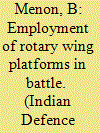

|
|
|
|
|
| Publication |
2014.
|
| Summary/Abstract |
Apart from other roles, insurgencies in Malaya, Kenya, Zimbabwe, French lndo-China and Algeria saw helicopters being used for troop induction into and extraction from combat zones, rudimentary fire support to ground forces and surveillance. Most operations were confined to daytime and in relatively clear weather due to equipment limitations. In almost all scenarios, there was a marked asymmetry in terms at technology and equipment in favour of conventional forces. Some success in these operations led to the assumption that with the added advantages oi hover capability helicopters were relatively invulnerable when compared to fixed wing aircraft.
|
|
|
|
|
|
|
|
|
|
|
|
|
|
|
|
| 9 |
ID:
133053
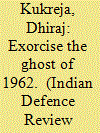

|
|
|
|
|
| Publication |
2014.
|
| Summary/Abstract |
To some, the lndia-China War, which started on October 20, i962 with the Chinese Army walking across the contested and an undetined border, was not a war at all but an armed incursion across the mountains, Call it by any name, the event continues to ranl
|
|
|
|
|
|
|
|
|
|
|
|
|
|
|
|
| 10 |
ID:
133056
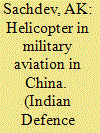

|
|
|
|
|
| Publication |
2014.
|
| Summary/Abstract |
China has the world's second largest defence budget next only to the US and with the future looking upbeat tor China's economy and for its military spending, defense manufacturers and contractors the world over are eyeing the Chinese military helicopter market. Meanwhile, the types being produced as "indigenous" lag behind the leading edge of helicopter technology as extant in the Western world. It the US relents over the arms embargo, there could be a signilicant change in the tenor and texture of China's military helicopter fleet, with implications for a possible future Sino-Indian armed conflict.
|
|
|
|
|
|
|
|
|
|
|
|
|
|
|
|
| 11 |
ID:
133058
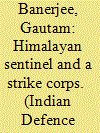

|
|
|
|
|
| Publication |
2014.
|
| Summary/Abstract |
The Indian Army remains handicapped in terms of its war making potential and lack of military infrastructure along the ever-vulnerable Indo-Tibet Border. The military men's cause was first dealt a telling blow by India's economic crisis of the early l990s and whatever of it was left to kindle, was extinguished thereafter by the crass failure of the lndian state in modernising its military. Regrettably, that debilitation was not led by just the impositions of fiscal, scientific and industrial stagnation, at its root lay a systemic aberration of security-blindness that seemed to have seized India's governing establishment, made up as it was of distracted political leadership, unaccountable bureaucracy, moribund military industry and marginalised military hierarchy.
|
|
|
|
|
|
|
|
|
|
|
|
|
|
|
|
| 12 |
ID:
133040
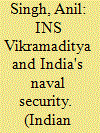

|
|
|
|
|
| Publication |
2014.
|
| Summary/Abstract |
'naval-vessel-building facilities are concerned, China and India are not at the same 'el. Over the past ten years, the People's Liberation Army Navy (PLAN) has built it') trigates and at least ten guided-missile destroyers, as well as advanced submarines. 'e weapons have been designed and made by China. On the other hand, India has Ilcl six destroyers and six trigates over the past ten years but currently only one ot those "in service.l0 Currently, the Indian Navy is seemingly relying on overseas purchases maintain its fleet in the future.
|
|
|
|
|
|
|
|
|
|
|
|
|
|
|
|
| 13 |
ID:
133057
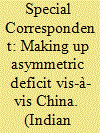

|
|
|
|
|
| Publication |
2014.
|
| Summary/Abstract |
China's surging economic power has been matched by increasing military might including investments in an aircraft carrier, anti-ship ballistic missiles, satellites, modern weapon systems and other hardware. In contrast, a decade at neglect at the Indian Military has widened the capability gap vis-a-vis PLA exponentially. With the new government in power headed by a dynamic Prime Minister, there is speculation of a new era in lndia-China relations. However, it would be prudent to remember that it is the capabilities that matter even it intentions change overnight.
|
|
|
|
|
|
|
|
|
|
|
|
|
|
|
|
| 14 |
ID:
133044
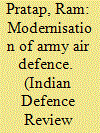

|
|
|
|
|
| Publication |
2014.
|
| Summary/Abstract |
As threats from the air play a decisive role in war, there will always be a need to protect the vital static assets as well as retain the freedom to manoeuvre mobile combat forces with no or minimum interference from the skies. The onus lies on the Army Air Defence to overcome the increasing challenges from the air with the enemy using sound strategic/tactical concept and efficient AD weapon systems. An effective AD system is thus a force multiplier for all the combat forces giving them the freedom to carry out operational tasks optimally,
|
|
|
|
|
|
|
|
|
|
|
|
|
|
|
|
| 15 |
ID:
133048


|
|
|
|
|
| Publication |
2014.
|
| Summary/Abstract |
Post 9/1 t, homeland security got tast tracked in the US and it is generally believed that the mainland has not suffered any terrorist incident since then aside from the Boston bombings at 2013 and periodic 'lone wolt' attacks. Most countries have come to realise that homeland security has a much wider canvas than protection lrom acts of violence. Within India, the tabric at homeland security apparently comprises a host of dots that are yet to be fully connected; integration of the security sector, intelligence, surveillance, national net-centricity et al. Homeland security involves pro-active policies and implementation in terms at analysis, reorganisation, diplomacy, intelligence gathering, building and synergising the security sector, or whatever it
takes to proactively detend the homeland. It goes for beyond civil detence.
|
|
|
|
|
|
|
|
|
|
|
|
|
|
|
|
| 16 |
ID:
133037
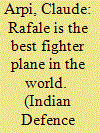

|
|
|
|
|
| Publication |
2014.
|
| Summary/Abstract |
Appointed as the Air Force Chief of Staff (CEMAA) on September 17, 2012, at the age of 53, General Denis Mercier had joined the French Air Force academy in 1979 and qualified as a fighter pilot in 1983. With 182 combat missions and more than 3,000 flying hours (mostly on Mirage F1C and Mirage 2000C) throughout his career, he has acquired extensive experience both as an operational commander and as a fighter pilot. In 2008, he was appointed Commander of the French Air Force Academy in Salon de Provence. Prior to becoming Air Chief, he was posted as a senior Military Advisor in the Ministry of Defence.
Claude Arpi met him on his return from Jodhpur where the Indo-French joint exercises 'Garuda V' were being held. That day, General Mercier flew a Sukhoi-30 MKI, while his Indian counterpart, Air Chief Marshal Arup Raha flew a Rafale. Excerpts from the Interview
|
|
|
|
|
|
|
|
|
|
|
|
|
|
|
|
| 17 |
ID:
133036
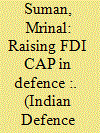

|
|
|
|
|
| Publication |
2014.
|
| Summary/Abstract |
it is time makes up its mind whether it wants FDI in defence or not. If it is felt that FDI is not essential and India can archive technological excellence through indigenous efforts; it should be stated upfront and all pretenses of seeking FDI should be shed. The current apathetic and uninspiring approach is a meaningless charade. The recent increase in FDI cap to 49 percent is totally inconsequential and will not attract FDI. this fact has been amply established by joint studies carried out by the CII with KPMG and ASSOCHAM with Ernst and young. both studies indicate that foreign investors want a minimum of 51 per cent holding.
|
|
|
|
|
|
|
|
|
|
|
|
|
|
|
|
| 18 |
ID:
133049
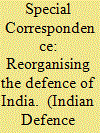

|
|
|
|
|
| Publication |
2014.
|
| Summary/Abstract |
Changes would provide a boost to defence preparedness, usher in an RMA, evolve requisite strategies and policies including tor national security, response to asymmetric war, defence procurements, R&D, technology acquisition and reorganizing the delenceindustrial base. Development and economic progress are undoubtedly priority tasks for the new government but national defence and security issues must be given equal importance it India is to gain its rightful place in the comity of nations.
|
|
|
|
|
|
|
|
|
|
|
|
|
|
|
|
| 19 |
ID:
133035
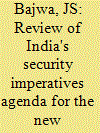

|
|
|
|
|
| Publication |
2014.
|
| Summary/Abstract |
The armed forces of a country are a manifestation of the Government's commitment to the people it represents of its concern for the pursuing the country's national interests, for providing people security and creating a safe environment for the people to achieve individual success and growth. The armed forces require constant nurturing and involvement of the executive authority. Well-trained and modernised armed forces cannot be bought off the shelf. The issues enumerated here are not a vague notional wishlist but fundamentals that impact various facets of security and the related modernisation of the Army. It is the right of every citizen to demand of the Government to ensure the territorial integrity of the nation and a peaceful internal environment for the well being of the people. The armed forces pay back fully in sweat and blood.
|
|
|
|
|
|
|
|
|
|
|
|
|
|
|
|
| 20 |
ID:
133055
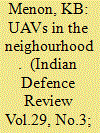

|
|
|
|
|
| Publication |
2014.
|
| Summary/Abstract |
Reports at Unmanned Aerial Vehicles (UAVs) being used tor private and commercial use are a regular feature in the media. Does it mean that there is going to be sudden surge of UAVs tlying in the Indian skies trailing advertising banners, delivering pizza or monitoring traffic? This is highly unlikely considering that unregulated use of UAVs for private and commercial use in civil airspace will result in chaos and accidents, In 1944, Clarence Johnson, the legendary founder of Lockheed's Skunk Works and the designer of the SR-71 and U2 reconnaissance aircratt, predicted that the tuture of military aviation would belong to the UAV. It appears that the prediction is slowly but surely coming true; now the market lor civil and commercial applications of UAVs is poised for spectacular growth
|
|
|
|
|
|
|
|
|
|
|
|
|
|
|
|
|
|
|
|
|